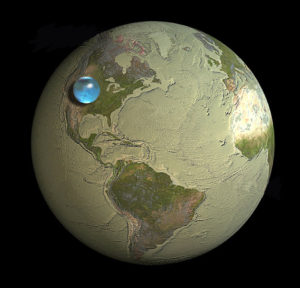The planets of our solar system formed out of a swirling disk of gas and dust billions of years ago. The material that accreted to become the Earth lacked water and organic material because it formed at a distance that was too close to the sun for such materials to condense and collect on the new-born planet.
Despite Earth’s rocky start, life organized, evolved, and now dominates this small, terrestrial planet orbiting 93 million miles away from the sun. How can this be?

Earth is a relatively dry planet, all the water in Earths oceans are less than 0.1 % of the earths Mass. Photo Credit: Howard Perlman, USGS/illustraion by Jack Cook, WHOI
Earth now exists within the habitable zone, which means that now liquid water can exist on the surface without freezing or boiling off into space. The water and organic ingredients for life that we have today were delivered to Earth objects after its formation and the atmospheric pressure on Earth allowed stable liquid water to exist.
Scientists understand this delivery process (and more) using computer models that simulate the formation of our solar system. “By applying these models to other planetary systems, we can investigate if exoplanets receive water and organics in the same way as Earth,” said Gijs Mulders, PhD., post-doctoral researcher in the Lunar and Planetary Laboratory at the University of Arizona.
The Genesis Database is a new tool and resource that will allow scientists to model the final stages of planet formation, according to Fred Ciesla, PhD., associate professor in the Department of the Geophysical Sciences at the University of Chicago. What makes this database so innovative is that it will run thousands of models at once—a whole order of magnitude more than the number of simulations that have previously been run, Mulders said.
More models allow for more examples of what can happen for a variety of planetary architectures. Both Ciesla and Mulders are interested in characterizing rare events. The Genesis Database will allow them to have a large set of simulations that reflect both the diversity in exoplanetary systems and some of the specific details of our solar system.
“If we change where we start each body, even just a little bit, we can get very different results. The number of planets may be different, their masses, or their compositions.” Ciesla said. “So if we want to understand the likelihood of getting something like the Earth, then we have to run a very large number of these simulations and think about the probability of getting different outcomes.”
Building a Model
To understand this, we first have to understand the basic model for solar system formation. First, disks containing the material for planets swirl around a star. Planets form like giant snowballs: Van der Waals’ interactions start to stick micrometer and millimeter-sized particles together, they then combine to form meter-sized objects, then kilometer-sized objects. These then coalesce and eventually form planetary embryos, roughly the size of Mars. In our solar system, this is roughly the largest body objects that can grow while the disk is still present. Once the disk is gone, the giant impact phase begins.
The giant impact phase is where most modeling begins. “This is an extremely important stage in planet formation because water and organics are delivered to the Earth,” Gijs Mulders said. “And we expect this to be the case in other planetary systems as well.”
Models start with many planetary embryos scattered around a star. State-of-the-art models require large amounts of computing power, and take months to simulate the process of planet growth and water delivery. “The entire evolution is determined by gravitational interactions between the growing planets and the bodies they accrete,” Ciesla said. Scientists then return to the model results and try to match them with actual, observable extrasolar systems.
The Search for Life
Planetary scientists best understand hot Jupiters—a type of giant, gaseous planet that orbit close to their stars—because they are easiest to detect. But terrestrial, Earth-like planets are where they are most likely to find life.
Unfortunately, Earth-like planets are much harder to characterize because they are so small and farther from their parent star, in the habitable zone. “We cannot directly measure their composition, so simulations are a crucial tool for understanding the water and organic content of planets in the habitable zone,” Mulders said. “The Genesis Database will become a valuable resource to study the composition of exoplanets in the habitable zone.”
